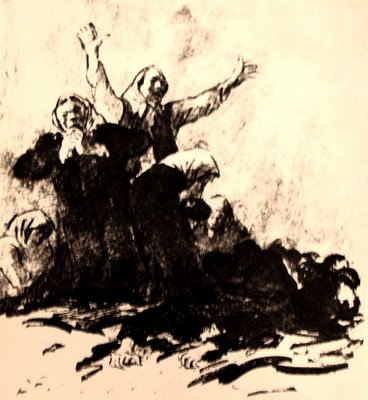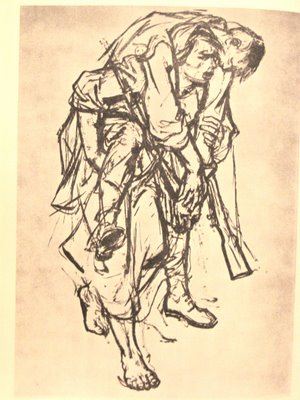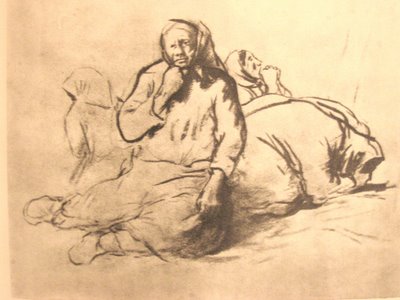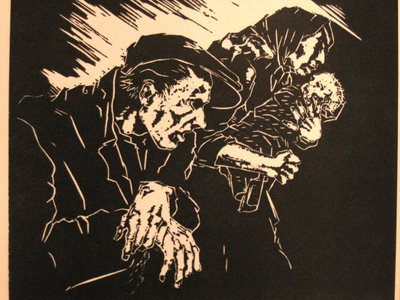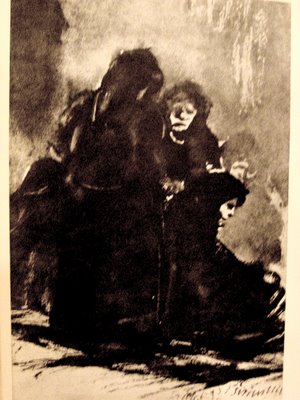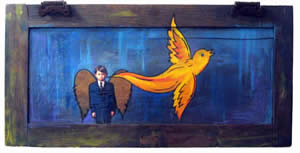
["Where To Now?" By David Andres Kietzman]
Visitors entering the gallery at Avenue 50 Studio in Highland Park, Los Angeles, were met with a space lit with candles and decorated with vases of marigolds. Groups slowly moved from piece to piece, or lingered to absorb the unapologetically heavy content.
An art show about remembering the souls of dead children? Most gallery directors would never approach such a theme for purely commercial reasons. Others might try but would instead produce a show laden with treacle, diverting the viewer from responses deeper and more constructive than tears and grief.
Kathy Mas-Gallegos is the well-known Director of Avenue 50 studio. She has approached this difficult theme with dignity, poetry and dry-eyed honesty, currating an exhibition that relates to the Mexican celebration of Dias De Los Muertos while providing social reflection and urgency. Ten artists were asked to produce work that commemorates, celebrates or mourns children and youth who have died an untimely death due to preventable disease, gang violence, abuse, and/or war. Ultimately this is an emotionally wrenching show.
The full name of the exhibition is "Miccailhuitontli - Spirit of the Children."
Say "Mick-Hail-Wheat-Tont-Lee", and you are pronouncing a word that dates from Aztec times. As Director of Avenue 50 Studio, Kathy Mas-Gallegos posted this descriptive statement about the theme of the show and it's origins:
"“Miccailhuitontli -— Spirit of the Children, a Mejica traditional celebration of DiŒa de los Angelitos.
According to the system of beliefs in deities particularly of the Mejica Aztecs, gods ruled parts of the earth, heavens and underground. Along with this, there were times during the year at which they honored these gods or the people they served. Miccailhuitontli represents a period of time in which deceased children were held in reverence. Miccailhuitontli was presided over by the goddess Mictecacihuatl, lady of the dead.
Eventually under the rule of the Spanish, Mejica tradition gave way to what we now know as the ceremonies of the days of the dead. In Mexico today, as perhaps in other parts of the world, there is a day to mourn and honor deceased children, as there is a day to mourn and honor deceased adults.
As the tradition goes in Mexico, paths are strewn with marigold petals leading to the house of the deceased child so that the soul can find its way back to its home and mingle once again, through spirit, with friends and loved ones.
As malevolent conditions in our world intensify, affecting the spirit and consciousness of our children - our future - is being destroyed. We honor these fallen children by bringing to the forefront those conditions that have wrought havoc in their young lives: war, gang violence, hatred, abuse, and preventable disease. We honor these fallen children in the hope that someone, or two or three, will hear and understand that only through determined action will crimes against children significantly decrease."
I was invited to contribute works, along with Edith and Rob Abeyta, Roberto L. Delgado, Kathi Flood, Clement Hanami, David Andreˆs Kietzman, Betsy Lohrer Hall, Ricardo Munoz, and Mark Vallen.
Betsy Lohrer Hall Dominates a main wall with what appears at first to be the installation of a shower of leaves, or many hanging branches of a weeping willow. Her "Lost and Missing Tree" is actually hundreds of squares of paper. Upon each the artist has hand-written the individual names, ages and causes of death of Iraqi children whose lives were taken during the last few years during warfare. Adding beauty and further heartbreak, the backs of each scrap are printed with designs borrowed from artworks looted from the Baghdad National Museum. The work speaks elloquently about the idea of loss...loss of a generation and of a culture. There is an inescapable connection that Hall had made with each of the names. The papers they are hand-written on are like little post-it notes...They are little reminders we make to ourselves about items we need desperately to remember.
Mark Vallen presents "Child Of War", an intimate work which hinges greatly upon precision and delicacy. As a realist painter, he unerringly depicts a single face of a young boy bearing an expression of fatigue, betrayal and spiritual damage. Vallen's "Child of War" could belong to dozens of cultures, but the artist's timely statement reminds viewers about the specifically incomprehensible civilian death toll mounting in the Iraqi War. Mark Vallen's choice to create a painting in his polished traditional style (reflecting an admiration of Renaissance masters) provides the viewer no escape from the dedication and proficiency of the artist's hand or intent. Indeed, to linger so sensitively over the subtle value changes of the boy's nostril, cheek and lips implies a deliberateness that casual sketchiness cannot compete with. Thus, the boy is given the same respect that might have been lavished upon the portrait of a young royal Duke at the hands of fourteenth century German painter Albrect Durer. Questions of worthiness and status are cast aside.
Kathi Flood has offered a work honoring the soul of a young local boy who was swept away by storm waters. Through text, we learn that his rescue was hindered by the lack of effective equiptment by authorities. It was only through his loss that proper poles and extention devices came into use. The playful appearance of the installation disolves as viewers are coaxed to recall their own memories of rescues caught on home video which top breathless news reports each winter.
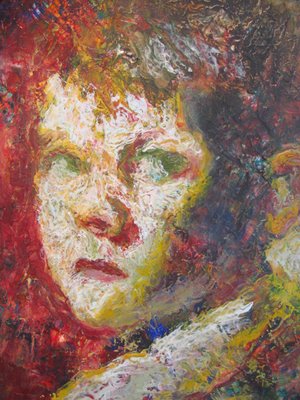
["Portrait of a missing child" By John Paul Thornton]
As for my own offering,I included five portraits of missing children, along with the disposable "Have You Seen Me?" mailers that inspired them. I too find that my somewhat obsessive continuation of this body of work, (I have created nearly four hundred painted portraits of America's missing children) reflects a kind of compulsive devotion which links the ten artists in the show together. Thank you to the many viewers I met at the opening night who were moved by my work. Thank you also to Kathy Mas-Gallegos, the Director of Highland Park's Avenue 50 Studio for this show about art and courage.


